Senegal, a vibrant country located in West Africa, is known for its rich culture, dynamic history, and strategic geographic positioning. As part of understanding Senegal’s geopolitical landscape, it is essential to explore its neighboring countries. Among them, Senegal’s neighbor to the east holds a unique significance due to its geographical and cultural characteristics. In this article, we will delve into the details of Senegal’s eastern neighbor, examining its role in the region and its relationship with Senegal.
Understanding Senegal’s Geographical Context
Senegal’s Position in West Africa
Senegal is situated in the westernmost part of Africa, bordered by the Atlantic Ocean to the west. Its strategic location places it at the crossroads of various African cultures and trade routes. To fully grasp the significance of Senegal’s neighbor to the east, it’s crucial to understand Senegal’s geographical context and its other neighboring countries.
Senegal is bordered by the following countries:
- Mauritania to the north
- Mali to the east
- Guinea to the southeast
- Guinea-Bissau to the southwest
Each of these countries plays a role in Senegal’s regional interactions, but our focus here is on the country situated directly to the east of Senegal.
Senegal’s Neighbor to the East: Mali
Geographic Overview
Mali, Senegal’s neighbor to the east, is a landlocked country that extends over a vast expanse of West Africa. Mali’s location makes it an important player in the region, serving as a bridge between the more coastal West African nations and the Sahara Desert to the north. The border between Senegal and Mali is characterized by a blend of different landscapes, including savannahs and river valleys.
Historical and Cultural Ties
Senegal and Mali share a deep historical and cultural connection. Both countries are part of the larger West African region, which has been influenced by historical empires such as the Mali Empire. The Mali Empire, one of the great medieval African empires, played a crucial role in the region’s development and had a significant impact on the culture and history of Senegal as well.
Shared Cultural Heritage
The cultural exchange between Senegal and Mali is evident in their music, art, and traditions. The griot tradition, a form of oral history and storytelling, is prevalent in both countries. Additionally, both nations celebrate similar festivals and share common culinary practices, reflecting their intertwined histories.
Economic and Political Relations
Trade and Economic Cooperation
The economic relationship between Senegal and Mali is robust, with trade being a significant component. Both countries engage in cross-border trade, exchanging goods and services. Mali’s landlocked status necessitates the use of Senegal’s port facilities for exports and imports, creating a symbiotic economic relationship.
Political and Diplomatic Relations
Politically, Senegal and Mali have maintained a cooperative relationship. They collaborate on various regional issues and are members of several regional organizations, including the Economic Community of West African States (ECOWAS). This cooperation extends to areas such as security, regional development, and political stability.
Challenges and Opportunities
Security Concerns
The region has faced security challenges, particularly in Mali, where conflicts and insurgencies have impacted stability. Senegal, as a neighboring country, has been involved in regional efforts to address these security concerns and support peace initiatives.
Opportunities for Collaboration
Despite the challenges, there are numerous opportunities for collaboration between Senegal and Mali. Joint projects in infrastructure development, environmental management, and cultural exchange programs offer potential benefits for both nations. Collaborative efforts can enhance regional integration and promote mutual prosperity.

FAQs
Senegal’s neighbor to the east is Mali. Mali is a landlocked country located directly to the east of Senegal and is an important player in the West African region.
Senegal and Mali share a historical connection through the Mali Empire, which significantly influenced the region’s culture and history. Both countries have a shared cultural heritage, including traditions and festivals.
The main economic interactions include cross-border trade, with Mali using Senegal’s port facilities for its exports and imports. Both countries also collaborate on regional economic projects and initiatives.
Senegal and Mali cooperate politically through various regional organizations, including the Economic Community of West African States (ECOWAS). They work together on issues related to security, regional development, and political stability.
Challenges include security concerns, particularly in Mali due to conflicts and insurgencies. However, both countries have opportunities for collaboration in areas such as infrastructure development, environmental management, and cultural exchange.
Conclusion
Senegal’s neighbor to the east, Mali, plays a crucial role in the West African region. The geographical, historical, and economic connections between Senegal and Mali highlight the importance of their relationship in regional dynamics. Understanding this relationship provides valuable insights into the broader context of West African geopolitics and cooperation. As both countries continue to navigate regional challenges and opportunities, their partnership remains a key component of West Africa’s stability and development.


